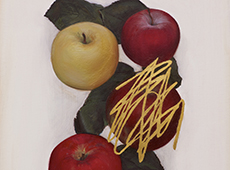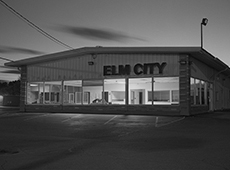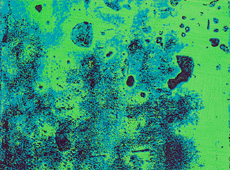In working, I try to crystallize all of my ideas, observations and impressions about line, architecture, color and geometry. At the same time, I try to keep the result open ended, so that the viewer can bring their own thoughts, and reinterpret their own experiences, to find that sensation of place that we hold in common.
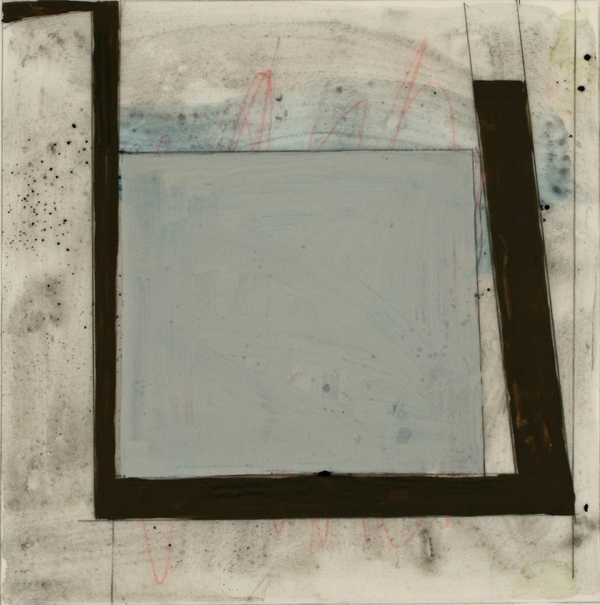
Elizabeth Gourlay, “cortile 1.” 2013. Pencil, graphite powder and gouache on vellum, 7 x 7 inches.
© Elizabeth Gourlay. Courtesy of the artist.
After an afternoon and evening roaming the streets of an ancient hill town in Italy, observing the light from the walls and buildings and sky light seen through overhanging eaves, I awoke the following morning with about 15 vivid abstract images of bold geometric lines and shapes fixed in memory. They seemed to be a perfect synthesis of the architecture and my recent thoughts about abstract art, in particular, Tantric meditative painting. I worked continuously over the next month to capture the qualities and specific colors, lines and geometries of these vision-paintings. This piece, cortile 1, is part of the broken line series and was made in my studio shortly after the initial works created in Italy. Although the original dream images are now no longer as vivid in my memory, the work conveys the same core ideas about architecture, color and geometry.
This work began, as mine often do, with a process of layering washes of color. Drawing elements followed the initial layering. Geometric elements emerge and I can recognize these as solid shapes and lines I had seen or imagined–stones, edges of buildings, courtyards, walls and eaves, some crisply edged, others softened by age, some echoing the calm and harmonious shapes of Palladio (who began his career as a stone cutter) or some with the elegance of Piero della Francesca. Others are simpler and cruder, like the ancient worn architecture of the Etruscans. The color also captures what was seen in my inner eye, combined with what I had observed in the painted stucco walls, limestone, alabaster, clay–the many rich and varied earth colors and the changing sky light.
In working, I try to crystallize all of my ideas, observations and impressions about line, architecture, color and geometry. At the same time, I try to keep the result open ended, so that the viewer can bring their own thoughts, and reinterpret their own experiences, to find that sensation of place that we hold in common.
This piece, coquelicot (French for the wild corn poppy), came several months after the initial series of works created in Italy. The red of the central shape grew richer and richer in intensity until it seemed to vibrate and hover in space. Not wanting to lose that, I worked to establish a balance between the dynamic red body and its play with the dark broken line and the atmospheric background spaces.
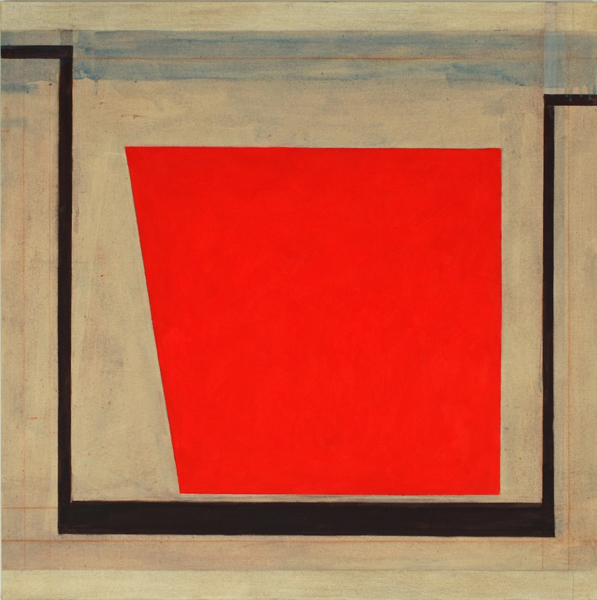
Elizabeth Gourlay, “coquelicot.” 2013. Pencil and acrylic on canvas, 40 x 40 inches.
© Elizabeth Gourlay. Courtesy of the artist.
Although I often have an image in my mind, I try to keep my conscious mind, the editor, in another room. This allows freedom to explore and expand intuitively on the initial vision, to incorporate unexpected and playful juxtapositions, to enter the “dialogue” with the piece while remaining honest to the original image. Paul Klee wrote about this, referring to the artist as “[s]tanding at his appointed place, at the trunk of the tree, he does nothing other than gather and pass on what comes to him from the depths….” James Turrell, in a 1999 interview with Richard Whittaker, talks about the artists’ inner vision:
But there is an idea, first of all, of vision fully formed with the eyes closed. Of course the vision we have in a lucid dream often has greater lucidity and clarity than vision with the eyes open. The fact that we have this vision with the eyes closed is very interesting. And the idea that it’s possible to actually work in a way, on the outside, to remind one of how we see on the inside, is something that became more interesting to me as an artist.
This next piece, number 68 (2013), also grew out of the series of vision-paintings from Italy. Working from a small gouache as a starting point, I established a background color with the central shape and the lines, some loosely drawn in pencil and others with a ruler. I built up the painted layers gradually and edited by washing out some of the lines, traces of which remain as part of the piece. Accidental marks are part of the process and remain or get painted out. In the finished work, the calm of the central Naples yellow trapezium plays with the surrounding and shifting dark umber and blue lines. The central shape could be seen as an area of light from a dusky sky (as in a Turell, though this only came later as an afterthought) or as a solid positive shape wrapped by the movement of the outside lines. These strong outside lines are architectural, and deliberately tip and lean and bend to create play between the lines themselves, the central shape and the edges of the painting.
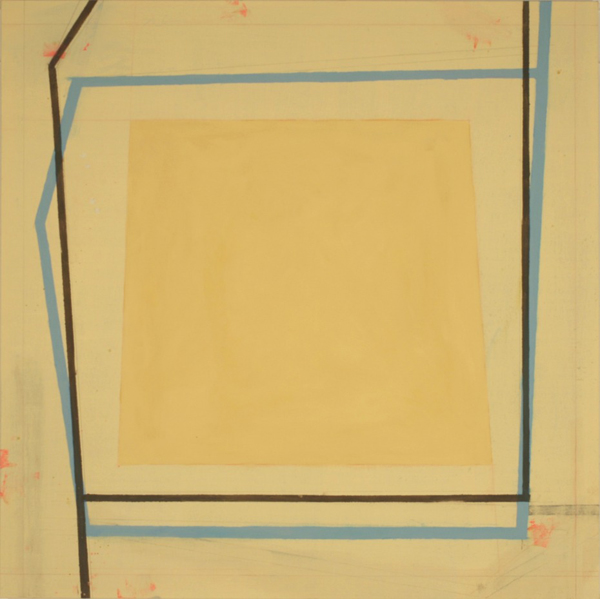
Elizabeth Gourlay, “number 68.” 2013. Pencil and acrylic on canvas, 40 x 40 inches.
© Elizabeth Gourlay. Courtesy of the artist.
In working, I try to crystallize all of my ideas, observations and impressions about line, architecture, color and geometry. At the same time, I try to keep the result open ended, so that the viewer can bring their own thoughts, and reinterpret their own experiences, to find that sensation of place that we hold in common.
Elizabeth Gourlay lives and works in Chester, CT.
Editor’s Recs:
Watch Elizabeth Gourlay in conversation with Zachary Keating and Chris Joy at Gorky’s Granddaughter, here. (2012).
Elizabeth Gourlay at Fred.Giampietro Gallery, New Haven.
Elizabeth Gourlay at Geoform.
Read Sharon Butler wonderful short take on Elizabeth Gourlay (2009) here.
Follow: our ongoing discussion of artists on process, here.
And our discussion with artists on memory, here.
Subscribe to Tilted Arc
If you like this story, please consider subscribing. We are sticklers for privacy.
We will never sell or share your e-mail address.

